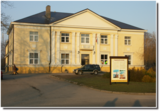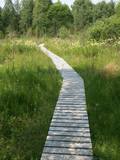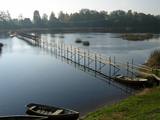| Nr | Nosaukums | Apraksts |
|---|---|---|
|
Saimniecība nodarbojas ar 15 veidu vīna darīšanu no Latvijas augļiem, ogām un citām dabas veltēm, kā arī vīna destilāta ražošanu. Vīna darītavā vīndaris pastāstīs par vīna izgatavošanu un dalīsies savā pieredzē. Uz vietas iespējams nobaudīt dažādus izsmalcinātus augļu un ogu vīnus, meklējot sev tīkamākās garšu un smaržu nianses. Vīna darītava sadarbojas ar vietējo zemnieku saimniecībām, tēdēļ pie vīna iespējams nobaudīt sieru no govs vai aitas piena un Bauskas pusē ražotus saldumus. |
||
|
36 ha lielajos saimniecības laukos Latvijas – Baltkrievijas pierobežā ganās gotiņas, no kurām gada laikā iegūst ap 10 t piena, kas tiek pārstrādātas uz vietas. Piedāvā biezpienu, krējumu, dažādu siera veidu šķirnes, mājas saldējuma un gaļas izstrādājumu iegādi un degustāciju. Iespējama līdzdarbošanās. Latgales kulinārā mantojuma tīkla dalībnieks. Bioloģiskā saimniecība. |
||
|
Viens no diviem nacionālā parka skatu torņiem, kas atrodas ~ 1,5 km ziemeļos no Ehijerva ezera (Ähijärv). Tornis ir veiksmīgi „nomaskēts” nelielā priežu pudurī, tādēļ tas „nebojā” izcilo dabas un kultūrainavu, kas paveras no tā skatu platformas. Pie autostāvlaukuma ir izveidota labiekārtota atpūtas vieta. |
||
|
Bestes apartamenti ir jauna viesu māja, kas spēj vienlaicīgi uzņemt 45 viesus (+10papildvietas). Viesu nams būvēts un veidots latviskā stilā (koka ēka, kas galavota tepat Mūrmuižā), izmantotas Latvijā ražotas gultas (Nakts mēbeļu meitas uzņēmums), Latvijā ražota gultasveļa (Mežroze) utt. |
||
|
No dārza un meža ogām, pārmantojot paaudžu tradīcijas, gatavo mājas vīnu. Piedāvā 4 vīnu degustāciju ar uzkodām un filozofiskas sarunas par vīna gatavošanas receptēm. Produkcijas iegāde. |
||
|
Atrodas Tukuma centrā. Piedāvā latviešu ēdienus. Sadarbojas ar vietējiem zemniekiem un lauku labumu ražotājiem. |
||
|
Restorāns - burgernīca "Raganas Burgers" specializējas 100% Latvijas liellopa burgeru, izmeklētu picu un frī kartupeļu pagatavošanā. Vasaras sezonā bērniem pieejamas atrakcijas nožogotā teritorijā un rotaļu ekskavators, izveidota arī baskāju taka. Iespēja blakus novietot auto. |
||
|
Atrodas Lielajā ielā 9. Dievnams celts 1742. - 1758. g. (J. K. Dorna projekts) pilsētas vācu draudzes vajadzībām, bet 55 m augstā torņa celtniecību pabeidza 1866. gadā. Baznīcas fasāde un interjers ir veidots vēlīnā baroka stilā ar klasicisma (interjerā – arī grezni rokoko stila elementi) iezīmēm. Dievnams pazīstams ar 1773. - 1780. g. būvētajām (H. A. Konciuss) ērģelēm. Pēc 1885. g. pārbūves instrumentam ir > 7000 stabuļu, 131 reģistrs un 4 manuāļi. Tas ir nominētas kā pasaulē lielākās mehāniskās ērģeles, kurās vērts ieklausīties koncertu laikā! Apmeklētāji var apskatīt baznīcu, ērģeles un uzkāpt tornī. |
||
|
Viesu nams "Stikāni" atrodas 2km no Nagļiem, pašā Orenīšu dīķu krastā. Viesu namā atrodas 4 labiekārtoti, komfortabli divvietīgi numuriņi un ēdamistaba ar izeju uz dārza terasi. Viesi var pasūtīt ēdināšanas pakalpojumus vai arī gatavot paši - virtuvē ir viss nepieciešamais aprīkojums. Blakus ēkā atrodas dabas tūrisma informācijas centrs, kurā ceļotāji var pieteikties putnu vērošanas ekskursijām tuvējā apkaimē. Mājai piederošajā teritorijā ir izveidota dabas taka, kurā zinoša gida pavadībā iespējams iepazīt Latvijai raksturīgos kokus un krūmus, populārus un mazāk zināmus ārstniecības augus un lielu daļu pie mums ligzdojošo putnu (vasarā) vai arī vērot iespaidīgu putnu migrāciju pavasaros un rudeņos. Dārzā putnus var vērot arī no speciāla slēpņa. |
||
|
Kaut arī no 104 ciema mājām 1. pasaules karā nopostīja 97, 20. gs. trīsdesmito gadu beigās Lapmežciems ātri „atkopās", un tajā darbojies viens no Latvijas piekrastes spēcīgākajiem zvejnieku kooperatīviem. Padomju laikā te izveidoja vienu no lielākajiem zvejniecības kolhoziem – „Selga", kura korpusi ir redzami pie Siliņupes ietekas. Šodien Lapmežciems ir iecienīts vasarnīcu rajons, atpūtas un peldvieta. Kā interesants zvejniecības vēstures piemineklis ir apskatāms Lapmežciema sedums - kādreizējā zvejas laivu piestātne, kur zvejnieki cēla tīklu būdas un glabāja inventāru. Starp Pīlādžu ielu un Siliņupes kreiso krastu 3. – 2. g.t. pr. Kr. atradās zvejnieku un mednieku apmetne, kuras vietā uzstādīts piemiņas akmens. Šī ir senākā zināmā cilvēka apdzīvotā vieta Ķemeru nacionālā parka teritorijā. Daļa no atradumiem ir apskatāma Lapmežciema muzejā, kur izveidota novadpētnieciska ekspozīcija un savākti materiāli par somu jēgeru cīņām Klapkalnciema apkārtnē. |
||
|
Smeceres krogs atrodas netālu no Madonas pie Smeceres sila. 17. gadsimtā celtajā kroga ēkā atrodas viesu nams, krogs - kafejnīca un mūzikas klubs. Kafejnīcas piedāvājumā gan latviešu, gan mūsdienu pasaules virtuves ēdieni. Vasarā darbojas āra terase. Iespējama banketu rīkošana un apkalpošana. |
||
|
Liellaiva ir speciāli Peipusa un Emajegi apstākļiem pielāgots viduslaiku preču burinieks, kādi bija pazīstami jau 14. gadsimtā. 2006. gadā pēc piecdesmit gadu ilga pārtraukuma Emajegi ūdeņos atkal tika nolaista šāda liellaiva ar nosaukumu "Jõmmu". Liellaivu biedrība (Emajõe Lodjaselts) rīko dažādus izbraucienus un dabas tūrisma pasākumus pa upi un Peipusa ezeru. Uz "Jõmmu" klāja tiek gaidīti arī mazie laivu draugi, lai iepazītos ar seniem rokdarbiem un laivu būvēšanu. |
||
|
Atrodas Grobiņas centrā, Dzērves laukuma malā. Pirmā baznīca Grobiņa bija celta jau ap 1560. g., bet nākamā – 1596. g. celtā iznīcināta 1659. g. zviedru iebrukuma laikā. Pēc Kurzemes un Zemgales hercoga Jēkaba Ketlera iniciatīvas 1664. g. tiek uzcelts jauns dievnams, ko atjauno 1892. gadā. Tas dedzis 2. pasaules kara laikā, bet vēlāk atkal atjaunots. Šobrīd notiek altāra restaurācijas darbi. |
||
|
1,2 km garā taka atrodas netālu no vietas, kur Gauju šķērso Vidzemes šoseja (A 2). Izejot taku, var iepazīt vienu no Latvijas augstākajiem dolomītiežu atsegumiem – Randātu klintis, kas paceļas 25 m virs Gaujas. Taka ir apļaveida un tās apskatei nepieciešamas ~ 45 minūtes. |
||
|
Pēc platības - salīdzinoši nelielais liegums veidots Zviedrijas kadiķa un tā dzīvesvietas – kaļķaino pļavu aizsardzībai. Lieguma apskatei izveidota marķētā lokveida taka, kas iepazīstina ar vienu no retajām, bet izcilākajām Latvijas kadiķu audzēm (50 – 70 gadi), apkārtnes biotopiem, augu un dzīvnieku sugām. Kadiķu tīraudzes Baltijā veidojušās cilvēka saimnieciskās darbības (pļaušana, ciršana u.c.) un noganīšanas (g.k. ar aitām) rezultātā. Arī tagad nelielu audzes daļu „apsaimnieko” aitas. Diemžēl, daudzi kadiķi teritorijas aizaugšanas gaitā ir aizgājuši bojā. |
||
|
Ap 400m garš un līdz 16m augusts atsegums upes kreisajā krastā.
|
||
|
Kājāmgājējiem un putnu vērotājiem domāta taka, kas izveidota ļoti interesantā Rīgas līča krastā pie Kaltenes, kur vērojami mazi līcīši un zemesragi, akmeņaina vai aizaugusi piekraste. Takas galā atrodas putnu vērošanas tornis, jo pavasara un rudens migrāciju laikā Kaltenes apkārtnē novērojama liela zosveidīgo, tārtiņveidīgo u.c. putnu daudzveidība.
|
||
|
Viena no retajām vietām pasaulē, kur joprojām nēģus rūpnieciskā mērogā zvejo, izmantojot > 150 gadu senu metodi – taci, kas ir pāri upei uzcelta laipa ar murdiem. Uz Salacas ir trīs tači. Vietējā zvejnieka pavadībā var iepazīt zvejas procesu, nobaudīt un iegādāties uz vietas ceptus nēģus. |
||
|
Uzņēmumā jau 16 gadus ražo klasiskos, medus, piparmētru – ingvera un smiltsērkšķu cukurgailīšus u.c. konditorejas izstrādājumus, kā arī gatavo zemestauku sulu, kas ir sen pazīstams tautas dziedniecības līdzeklis. Produkcijas iegāde. |
||
|
0,2 km austrumos no Vidsmuižas atrodas no šķeltajiem laukakmeņiem un sarkanajiem ķieģeļiem celtā (1910. - 1912. g.) Vidsmuižas katoļu baznīca. Tāpat kā Riebiņos esošā, arī šī ir uzskatāma par tipisku 19. – 20. gs. mijas Latgales lauku baznīcas paraugu. |
||























